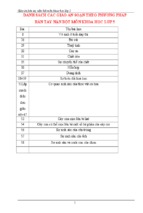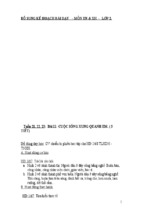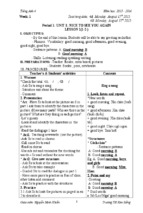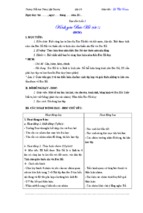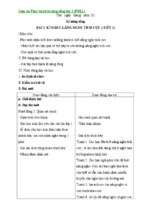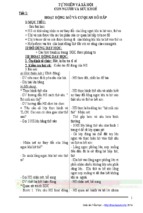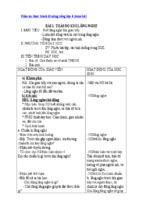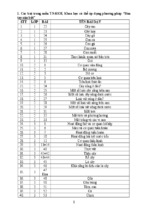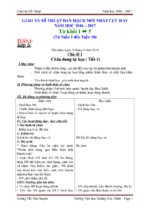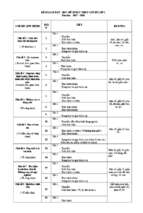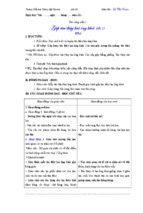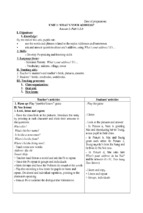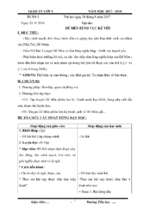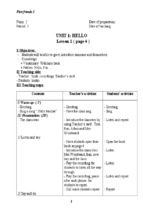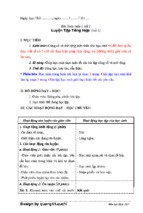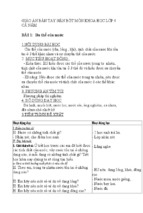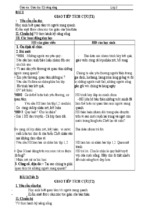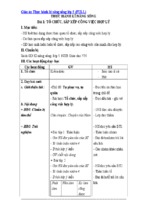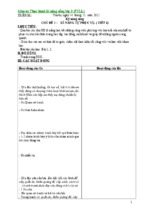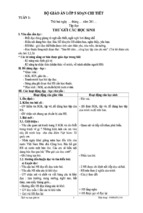giáo án tiếng anh 4 2016-2017
Gi¸o ¸n TiÕng Anh líp 4
N¨m häc 2014-2015
Date of preparing: November 15 th, 2014
Week:11
Period 1
Unit 1: Good morning. How are you?
Lesson 1
I. Overview:
1. Objectives:
- By the end of this lesson, students will be able to greet someone
formally
- Develop speaking skill.
2. Teaching aids:
- Teacher’s aids: book, word cards, pictures, tape, cassette, puppets.
- Students’ aids: books, notebooks, workbooks.
3. Languages focus:
- Phonics: morning. afternoon
- Vocabulary: morning, afternoon, evening
- Structures: Good morning, Miss Hien.
II. Procedures:
Teacher’s and student’s activities
The target
language
I. Warm up Chatting.
- Let Ss introduce some information about themselves
(maybe in Vietnamese) and introduces oneself in English.
Example: Hello. I’m Van. (Hi. I am Van).
II. New lesson.
1. Listen and repeat
- Have Ss open their book page 6. Ask Ps the names of the
characters and what they say.
- Play the recording and asks Ss to listen to the tape twice.
- Play the recording again for Ps to repeat each line.
- Divide the class into 2 groups. Ask 1 group to repeat Miss
Hien’s part and the other the P’s part.
- Check to make sure Ps can repeat and understand the
dialogue.
- Whole class repeats in chorus.
2. Look and say:
- Have Ss look at the picture on page 6 and identify the
characters in these pictures
- Ask Ps to identify what part of the day it is in each picture
- Do the task with one people as an example.
- Have Ss to work in pairs. (greetings and responses)
- Repeat the step but this time asks Ps to swap their roles.
Gi¸o viªn Phïng ThÞ Nhµn
Repeat the way
to greeting
someone
formally:
Good morning.
Good afternoon
Good evening.
Ss greeting
based on the
vocabulary and
picture which
are given.
Gi¸o ¸n TiÕng Anh líp 4
N¨m häc 2014-2015
- Monitor the activity, check the pronunciation (sound,
assimilation of sound and intonation) and offer help when
necessary.
- Call on some pairs to perform the task at the front of the
class. Others observe and comment.
- Make some questions to check Ss’ comprehension of
language
- Have the whole class repeat all the phrases to reinforce
their pronunciation.
3. Talk:
- Have Ss look at the pictures on page 7 and identify the
characters in the pictures.
- Tell Ps that they are going to practice greeting and
responding to greeting.
- Ask Ps to work in pairs to role play the greeting and
responses.
- Invite some pairs to talk.
- Monitor the activity and offer help if necessary
- Have the whole class repeat all the phrases to reinforce
their pronunciation.
4. Listen and tick
- Ps open page 7. Tell them that they are going to listen to
the recording and tick the correct answers.
- Play the recording for Ps to listen as they read.
- Play the recording again for Ps to listen and tick the
correct answers.
- Play the recording again for Ps to listen to check answers.
- Ask Ps to exchange their answers with their partners
- Check the answers to the class.
III. Home- link:
- Learn and write new words and structures.
- Prepare for the next lesson.
Date of preparing: November 15th, 2014
Gi¸o viªn Phïng ThÞ Nhµn
Ss greeting
based on the
picture given.
The use
language
themselves.
Develop pupils’
listening skills
with greeting
topic.
Gi¸o ¸n TiÕng Anh líp 4
N¨m häc 2014-2015
Week: 11
Period 2
Unit 1: Good morning. How are you?
Lesson 2
I. Overview:
1. Objectives:
- By the end of this lesson, students will be able to greet someone
formally
- Develop speaking skill.
2. Teaching aids:
- Teacher’s aids: book, word cards, pictures, tape, cassette, puppets.
- Students’ aids: books, notebooks, workbooks.
3. Languages focus:
- Phonics: morning. afternoon
- Vocabulary: morning, afternoon, evening
- Structures: Good morning, Miss Hien.
II. Procedures:
Teacher’s and student’s activities
The target
language
I. Warm up : Slap the board
Cards: Good morning, good afternoon, good evening, good
night, good bye.
II. New lesson.
1. Listen and repeat
- Pronounce the words: morning, afternoon
- Tell pupil to pronounce these sounds correctly.
- Play the recording and asks Ss to listen to the tape twice.
- Play the recording again for Ps to repeat each line.
- Repeat in chorus and individually.
Repeat:
morning,
afternoon
Good morning.
Good afternoon
2. Listen and number
- Identify the part of the day in each pictures.
- Play the recording through for pupils to listen.
- Play the recording again for pupils to do the task.
- Play the recording to check answers.
-Announce the answers to the pupils.
Be able to hear
and understand
the vocabulary
about greeting.
then tick the
correct pictures.
3. Read and tick:
- Tell pupils that they are going to read and tick the correct
pictures.
Gi¸o viªn Phïng ThÞ Nhµn
Gi¸o ¸n TiÕng Anh líp 4
N¨m häc 2014-2015
- Pupils do the task individually and then exchange their
answers with a partner.
- Invite pupils to give answers.
- Announce the answers.
4. Let’s play.
-Tell pupils that they are going to play Bingo game.
_Tell the rule of the Bingo game.
BINGO
good morning
good afternoon
good evening
good bye
good night
hello
III. Home- link:
- Learn and write new words and structures.
- Prepare for the next lesson.
--------------------------------------------------Date of preparing: November 15th, 2014
Week: 11
Period 3
Unit 1: Good morning. How are you?
Lesson 3
I. Overview:
1. Objectives:
- By the end of this lesson, students will be able to greet someone
formally
- Develop speaking skill.
2. Teaching aids:
- Teacher’s aids: book, word cards, pictures, tape, cassette, puppets.
- Students’ aids: books, notebooks, workbooks.
3. Languages focus:
- Phonics: morning. afternoon
- Vocabulary: bored, happy, ok
- Structures: How are you ? – I’m fine, thank you.
II. Procedures:
Teacher’s and student’s activities
Gi¸o viªn Phïng ThÞ Nhµn
The target
Gi¸o ¸n TiÕng Anh líp 4
N¨m häc 2014-2015
language
Warm up:
Chatting
- T asks Ss to repeat the greeting and introducing oneself.
1. LISTEN AND REPEAT.
Elicit the character and have Ss guess what they are
saying.
Set the scene: we are going to review phrases saying
hello and bye.
Play the recording for Ss to repeat the lines in the speech
bubbles three times.
Divide the class into two groups. One repeat Mai’s part
and the other repeat Nam’ part.
Play the recording again for the whole class to repeat
each line in the speech bubbles to reinforce their
pronunciation.
Elicit the structures.
2. LOOK AND SAY.
Have Ss look at the pictures a, b, c and d on page 10
Elicit the characters in the pictures and their names. Ask
Ss to guess and complete the speech bubbles.
T models/ allocates the parts of characters Mai and Nam
to Ss
Ask them to act out the dialogue1. Repeat the step with
some other pairs for pictures b, c, d
Have Ss practice acting out the dialogue in pairs, using
the pictures.
Monitor the activity. Correct the errors if necessary.
Call on some pairs to perform the task at the front of the
class. The others observe and give comments.
Give feedback.
3. WRITE.
Get Ss to identify the characters in the pictures.
Tell Ss that they are going to read and get information to
write the missing words in dialogue 1 and 2.
Ss read silently and complete the dialogues.
Ss trade their answers within pairs or groups for
correction
Ask Ss to read the answers aloud to the class. The others
listen and give comments.
Home- link:
Consolidate the content of the lesson.
Ask Ss to learn and write new words and structure.
Gi¸o viªn Phïng ThÞ Nhµn
Practice the
dialogue, know
the new
structure:
How are you?
Practice talking
based on the
pictures and
vocabulary.
Write the
missing words
that they have
learnt.
Gi¸o ¸n TiÕng Anh líp 4
N¨m häc 2014-2015
Date of preparing: November 19th, 2014
Week: 12
Period 4
UNIT 2: MY NEW FRIENDS
LESSON 1
I. Overview:
1. Objectives:
By the end of this lesson, students will
- Be able to ask an answer questions where someone is from.
- State one’s own nationality or nationality of others.
- Ask and give the full name of a pupil/person.
- Develop speaking skill.
2. Teaching aids:
- Teacher’s aids: book, word cards, pictures, tape, cassette, puppets.
- Students’ aids: books, notebooks, workbooks.
3. Languages focus:
- Phonics: Vietnamese
- Vocabulary: England, English, America American, Australia,
Australian,Vietnam, Vietnamese,China, Chinese,Japan, Japanese,full,
name.
- Structures: -Where are you from ?
I’m from England.
I’m Vietnamese.
What’s his full name ?
Tom Green
II. Procedures:
Teacher’s and student’s activities
The target
language
Warm up
Hangman
J-A-P-A-N
1. Listen and repeat
- Have Ss open their book page 12. Ask Ps the names of the
characters and what they say.
- Play the recording and asks Ss to listen to the tape twice.
- Play the recording again for Ps to repeat each line.
- Divide the class into 2 groups to practice.
- Check to make sure Ps can repeat and understand the
dialogue.
- Whole class repeats in chorus.
2. Look and say:
- Have Ss look at the pictures and identify the countries.
Gi¸o viªn Phïng ThÞ Nhµn
Repeat the way
to ask and
answer where
someone is
from?
Ask and answer
Gi¸o ¸n TiÕng Anh líp 4
N¨m häc 2014-2015
- Teach the new words: Japan, America and Australia and
structure: -Where are you from? -I’m from England.
- Ask pupils to ask and answer the questions -Where are you
from? using the puppets of Akio and Mai as example.
- Ask pupils to practice asking and answering based on the
cues.
- Select some pairs to practice.
- Give feedback.
3. Talk:
- Have Ss look at the pictures on page13 and identify the
characters in the pictures.
- Tell Ps that they are going to practice asking and
answering
- Ask Ps to work in pairs to role play the greeting and
responses.
- Invite some pairs to talk.
- Monitor the activity and offer help if necessary
- Have the whole class repeat all the phrases to reinforce
their pronunciation.
4. Listen and tick
- Ps open page 13 Tell them that they are going to listen to
the recording and tick the correct answers.
- Play the recording for Ps to listen as they read.
- Play the recording again for Ps to listen and tick the
correct answers.
- Play the recording again for Ps to listen to check answers.
- Ask Ps to exchange their answers with their partners
- Check the answers to the class.
III. Home- link:
- Learn and write new words and structures.
- Prepare for the next lesson.
Gi¸o viªn Phïng ThÞ Nhµn
where someone
is from
Be based on the
vocabulary and
picture which
are given.
Ask and answer
where someone
is from based
on the pictures.
Listen and tick
the mentioned
picture.
Gi¸o ¸n TiÕng Anh líp 4
N¨m häc 2014-2015
Date of preparing: November 19th, 2014
Week: 12
Period 5
UNIT 2: MY NEW FRIENDS
LESSON 2
I. Overview:
1. Objectives: Pupil will be able
- to pronounce correctly the sounds of letter ese
- to say what nationality they are or what nationality others are
- to listen and to read for specific information.
II. Procedures:
Teacher’s and student’s activities
The target
language
Warm up : Slap the board
Cards: English, American, Vietnamese
1. Listen and repeat
- Pronounce the words: Vietnamese
- Tell pupil to pronounce these sounds correctly.
- Play the recording and asks Ss to listen to the tape twice.
- Play the recording again for Ps to repeat each line.
- Repeat in chorus and individually.
2. Listen and number
- Identify the nationality in each picture.
- Play the recording through for pupils to listen.
- Play the recording again for pupils to do the task.
- Play the recording to check answers.
-Announce the answers to the pupils.
3. Read and circle:
- Tell pupils that they are going to read and circle.
- Pupils do the task individually and then exchange their
answers with a partner.
- Invite pupils to give answers.
- Announce the answers.
4. Let’s play.
JUMBLE LETTERS
Jaeseapn: Japanese
Gi¸o viªn Phïng ThÞ Nhµn
Repeat:
Vietnamese
Be able to hear
and understand
the vocabulary
about
nationality.
Read and circle
the correct
answers related
to nationality
Gi¸o ¸n TiÕng Anh líp 4
N¨m häc 2014-2015
ieshnCe: Chinese
iesemtneaV: Vietnamese
III. Home- link:
- Learn and write new words and structures.
- Prepare for the next lesson.
Date of preparing: November 19th, 2014
Week: 12
Period 6
UNIT 2: MY NEW FRIENDS
LESSON 3
I. Overview:
1. Objectives: Pupil will be able
- to ask and give the full name of a pupil/ person.
II. Procedures:
Teacher’s and student’s activities
Warm up: Sing
Sing the chant on page 14
The target language
1. LISTEN AND REPEAT.
- Elicit the character.
- Set the scene: we are going to listen and
Practice the dialogue.
repeat the dialogue between Miss Hien and Mrs.
Green.
- Play the recording for Ss to repeat the lines in
the speech bubbles three times.
- Divide the class into two groups. One repeat
Mai’s part and the other repeat Nam’ part.
- Play the recording again for the whole class to
repeat each line in the speech bubbles to
reinforce their pronunciation.
- Elicit the structures.
2. LOOK AND SAY.
- Have Ss look at the pictures at page 16
- Elicit the names of characters in the pictures
- Do the task with one pupil as a model.
- Ask pupil to talk in pairs. One asks and one
answers.
Gi¸o viªn Phïng ThÞ Nhµn
Based on the pictures and
vocabulary
Practice talking
What’s his full name?
His full name is.....
Gi¸o ¸n TiÕng Anh líp 4
N¨m häc 2014-2015
- Monitor the activity. Correct the errors if
necessary.
- Call on some pairs to perform the task at the
front of the class. The others observe and give
comments.
- Give feedback.
3. WRITE.
- Tell Ss that they are going to write a letter to a
new pen friend in another country.
- Ask pupils to read and how to complete it.
- Invite a good pupil to complete the letter on
the board and then delete.
- Ask pupils to write themselves.
- Ask them to exchange their letter in pairs and
comment the letters.
- Call some pupils to read aloud their letters
- Give feedback.
4. SING
- Tell pupils that they are going to sing a song about a
child who could not spell his full name.
- Play the recording through.
- Sing each line and get pupils to repeat.
- Play again and get pupils to sing along. (two times)
Home- link:
- Practice “What’s his full name?” and answer.
- Sing the song on page 17.
Gi¸o viªn Phïng ThÞ Nhµn
a.Le Nam
b.Linda Brown
c.Tom Green
d.Tony Black
Be able to write a letter
using the form below:
Dear...........,
My name is...............
I’m from....................
I’m........... years old.
I like..........................
Write soon,
.........
Be able to sing:
What’s your full name?
What’s your full name?
Tony Black.
Tony Black.
How do you spell it?
How do you spell it?
I don’t know.
Do you know?
Gi¸o ¸n TiÕng Anh líp 4
N¨m häc 2014-2015
Date of preparing: November 25th, 2014
Week: 13
Period 7
UNIT 3: MY BIRTHDAY
LESSON 1
I. Overview:
1. Objectives:
- Ask and answer questions about when someone’s birthday is.
- Ask and answer about date.
2. Teaching aids:
- Teacher’s aids: book, pictures, tape, cassette, puppets.
3. Languages focus:
- Phonics: September, June
- Vocabulary: January, February, March, April, May, October, June,
August, November, July, September, December
first, second, third, fourth, fifth, birthday, date, today, of when.
Structures: -When’s your birthday ?
-It’s in May.
-What’s the date today ?
-It’s the fifth of October.
II. Procedures:
Teacher’s and student’s activities
The target
language
Warm up Sing
Sing the song on page 17.
1. LOOK, LISTEN AND REPEAT
- Have Ss open their book on page 18
- Tell pupils that they are going to listen and repeat the
dialogue between Mai, Nga and Mr. Robot.
- Play the recording through for pupils to listen.
- Play the recording again twice for Ps to repeat each
line.
- Divide the class into 2 groups to practice.
- Ask pupils to practice in pairs.
Invite some pupils to practice in front of the class.
2. LOOK AND SAY:
- Teach new words.
- Have Ss look at the picture on page 18
Tell them that they are going to practice asking and
Gi¸o viªn Phïng ThÞ Nhµn
Be able to practice
talking the dialogue.
*New words:
January, February,
March, April, May,
Gi¸o ¸n TiÕng Anh líp 4
N¨m häc 2014-2015
answering the questions “When’s your birthday?”
- Do the task with one people as an example.
- Have Ss to work in pairs.
- Monitor the activity, check the pronunciation
- Call some pairs to perform the task at the front of the
class. Others observe and comment.
- Give feedback.
3. TALK:
- Ask pupils to open the book on page 19
- Tell them that they are going to practice asking and
answering questions about when someone’s birthday is.
- Do the task with one people as an example.
- T: When’s your birthday?
- Pupil: It’s in...June.....
- Have Ss to work in pairs.
- Monitor the activity, check the pronunciation
- Call some pairs to ask and answer at the front of the
class. Others observe and comment.
- Give feedback.
4. LISTEN AND TICK
- Ask pipils to open page 19. Tell them that they are
going to listen to the recording and tick the correct
answers.
- Play the recording for Ps to listen as they read.
- Play the recording again for Ps to listen and tick the
correct answers.
- Play the recording again for Ps to listen to check
answers.
- Ask Ps to exchange their answers with their partners
-Check the answers to the class.
Home- link:
- Learn and write new words and structures.
Prepare for the next lesson.
Gi¸o viªn Phïng ThÞ Nhµn
October, June,
August, November,
July, September,
December
*Question:
When’s your
birthday?
It’s in...June.....
Talk:
- When’s your
birthday?
- It’s in...June.....
Transcript:
1.-When’s your
birthday, Nam?
-It’s in April.
2.-When’s your
birthday, Phong?
-It’s in March.
Key: 1a, 2b
Gi¸o ¸n TiÕng Anh líp 4
N¨m häc 2014-2015
Date of preparing: November 25th, 2014
Week: 13
Period 8
UNIT 3: MY BIRTHDAY
LESSON 2
I. Overview:
1. Objectives:
- To pronoun the sounds: er and J
- To listen and to read for the specific information.
II. Procedures:
Teacher’s and student’s activities
Warm up
Slap the board
January
April
February
May
The target language
March
October
1. LISTEN AND REPEAT
- Pronounce the words: September, June
- Tell pupils to pronounce these sounds correctly.
- Tell pupils to look at the chant on the board.
- Play the recording through for pupils to listen.
- Play the recording again twice for Ps to repeat each
line of the chant.
- Ask pupils to practice in groups of 4.
- Invite some pupils to read aloud in front of the class.
September, June
January, February,
March, April, May,
June, July, August,
September, October,
November, December.
2. LISTEN AND NUMBER:
Transcript:
- Ask pupils to open page 20. Tell them that they are
going to listen to the dialogue and number the
pictures.
- Play the recording for Ps to listen as they read.
- Play the recording again for Ps to listen and tick the
correct answers.
- Play the recording again for Ps to listen to check
answers.
- Ask Ps to exchange their answers with their partners
- Announce the answers.
Gi¸o viªn Phïng ThÞ Nhµn
1. -Hi, Quan. When’s
your birthday?
-It’s in June.
2. -When’s your
birthday, Hoa?
-It’s in November.
3. -When’s your
birthday, Peter?
-It’s in June.
4. – Hello, Mary.
When’s your birthday?
-It’s in September.
Gi¸o ¸n TiÕng Anh líp 4
N¨m häc 2014-2015
3. READ AND NUMBER:
Answers:
- Ask pupils to open the book on page 21.
- Tell them that they are going to read and number the
lines in a dialogue. The first and the last are already
done. They have to number four lines.
- Ask pupils read and do the task individually.
- Monitor the activity, Give help if necessary.
- Ask some pupils to report their answers to the class.
- Announce the answers to the class.
4. LET’S SING
- Tell pupils that they are going to sing a song on the
occasion of someones’s birthday.
- Play the recording through.
- Sing each line and get pupils to repeat.
- Play again and get pupils to sing along. (two times)
- Invite some pupils to sing and give mark.
Home- link:
Review the lesson.
Prepare the next lesson.
Gi¸o viªn Phïng ThÞ Nhµn
1. Hi, Tom.
4. Happy birthday,
Linda
5. Thank you. When’s
your birthday?
5. Hello, Linda. Oh! A
nice cake!
3. Yes. It’s my birthday
today.
6. It’s in July.
Happy birthday
Happy birthday to you
Happy birthday to you
Happy birthday, dear
Linda
Happy birthday to you
Gi¸o ¸n TiÕng Anh líp 4
N¨m häc 2014-2015
Date of preparing: November 30th, 2014
Week: 13
Period 9
UNIT 3: MY BIRTHDAY
LESSON 3
I. Overview:
1. Objectives:
- To ask and answer “- What’s the date today? –It’s ......”
- To write birthday card.
II. Procedures:
Teacher’s and student’s activities
The target language
Warm up
Singing
Sing the song “Happy birthday”
1. LISTEN AND REPEAT
- Have Ss open their book on page 22
- Tell pupils that they are going to listen and repeat the
dialogue between Miss Hien and children.
- Play the recording through for pupils to listen.
- Play the recording again twice for Ps to repeat each
line.
- Divide the class into 2 groups to practice.
- Ask pupils to practice in pairs.
Invite some pupils to practice in front of the class.
2. LISTEN AND NUMBER:
- Teach new words.
- Ask pupils to open page 22.
Tell them that they are going to practice asking and
answering the questions “What’s the date today?”
- Do the task with one people as an example.
- Have Ss to work in pairs.
- Monitor the activity, check the pronunciation
- Call some pairs to perform the task at the front of the
class. Others observe and comment.
Give feedback.
3. WRITE:
Gi¸o viªn Phïng ThÞ Nhµn
New words:
first
second
third
fourth
fifth
sixth
seventh
eighth
nineth
tenth
Gi¸o ¸n TiÕng Anh líp 4
N¨m häc 2014-2015
- Tell Ss that they are going to write a birthday card
- Ask pupils to read and how to complete it.
- Invite a good pupil to complete the letter on the board
and then delete.
- Ask pupils to write themselves.
- Ask them to exchange their letter in pairs and
comment the letters.
- Call some pupils to read aloud their letters
- Give feedback.
4. LET’S CHANT
- Tell pupils that they are going to chant about the months
of the year.
- Play the recording through.
- Sing each line and get pupils to repeat.
- Play again and get pupils to sing along. (two times)
- Invite some pupils to sing and give mark.
Home- link:
Review the lesson.
Prepare the next lesson.
Gi¸o viªn Phïng ThÞ Nhµn
Dear...........,
..................................
From.............
Gi¸o ¸n TiÕng Anh líp 4
N¨m häc 2014-2015
Date of preparing: December 5h, 2014
Week: 14
Period 10
UNIT 4: THINGS I CAN DO
LESSON 1
I. Overview:
1. Objectives:
- Ask and answer questions about what someone can do.
- Ask and answer about abilities.
2. Teaching aids:
- Teacher’s aids: book, pictures, tape, cassette, puppets.
3. Languages focus:
- Phonics: can; can’t
- Vocabulary: swim, draw, dance, ride a bike, play the piano, use the
computer, play badminton.
Structures: -What can you do?
-I can dance.
-Can you play badminton.
Yes, I can. / No, I can’t.
II. Procedures:
Teacher’s and student’s activities
The target
language
Warm up
Hangman
D-A-N-C-E
1. LOOK, LISTEN AND REPEAT
- Have Ss open their book on page 24.
- Tell pupils that they are going to listen and repeat the
dialogue between Mai, Nam and Phong.
- Explain the meaning of draw and sing.
- Play the recording through for pupils to listen.
- Play the recording again twice for Ps to repeat each
line.
- Divide the class into 2 groups to practice.
- Ask pupils to practice in pairs.
Invite some pupils to practice in front of the class.
2. LOOK AND SAY:
- Teach new words.
- Have Ss look at the picture on page 24
Tell them that they are going to practice asking and
Gi¸o viªn Phïng ThÞ Nhµn
Be able to practice
talking the dialogue.
*New words:
use copmputer
play the piano
Gi¸o ¸n TiÕng Anh líp 4
N¨m häc 2014-2015
answering the questions “What can you do?”
- Do the task with one people as an example.
- Have Ss to work in pairs.
- Monitor the activity, check the pronunciation
- Call some pairs to perform the task at the front of the
class. Others observe and comment.
- Give feedback.
3. TALK:
- Ask pupils to open the book on page 25
- Tell them that they are going to practice asking and
answering questions about what they can do.
- Do the task with one people as an example.
- What can you do?
- I can draw a dog.
- Have Ss to work in pairs.
- Monitor the activity, check the pronunciation
- Call some pairs to ask and answer at the front of the
class. Others observe and comment.
- Give feedback.
4. LISTEN AND NUMBER
- Ask pipils to open page 25. Tell them that they are
going to listen to the recording and number the correct
pictures.
- Play the recording for Ps to listen as they read.
- Play the recording again for Ps to listen and tick the
correct answers.
- Play the recording again for Ps to listen to check
answers.
- Ask Ps to exchange their answers with their partners
- Announce the answers.
Home- link:
- Learn and write new words and structures.
- Prepare for the next lesson.
Gi¸o viªn Phïng ThÞ Nhµn
speak English
ride a bike
*Question:
What can you do?
I can use the
computer.
Talk:
What can you do?
I can draw a dog.
I can use a
computer.
I can ride a bike.
I can speak English.
Transcript:
1. What can you
do?
I can swim.
2. What can you
do?
I can draw a parrot.
3. What can you
do?
I can ride a bike.
4. What can you
do?
I can play the
piano.
Gi¸o ¸n TiÕng Anh líp 4
N¨m häc 2014-2015
Date of preparing: December 5th, 2014
Week: 14
Period 11
UNIT 4: THINGS I CAN DO
LESSON 2
I. Overview:
1. Objectives:
- To pronounce correctly the sound of the letters: an, an’t
- To listen and to read for the specific information.
2. Teaching aids:
- Teacher’s aids: book, pictures, tape, cassette, puppets.
3. Languages focus:
- Phonics: can; can’t
- Vocabulary: swim, draw, dance, ride a bike, play the piano, use the
computer, play badminton.
Structures: -What can you do?
-I can dance.
-Can you play badminton.
Yes, I can. / No, I can’t.
II. Procedures:
Teacher’s and student’s activities
The target
language
Warm up
Slap the board
Swim
Draw a parrot
Draw a cat
Ride a bike
1. LISTEN AND REPEAT
- Have Ss open their book on page 26.
- Tell pupils that they are going to listen to the chant and
pronounce can, can’t.
- Pronounce the focused sounds a few times as model.
Get pupils to say them several times.
- Play the recording through for pupils to listen.
- Play the recording again twice for Ps to repeat each
line.
- Ask pupils to practice in pairs.
- Invite some pupils to practice in front of the class.
2. LISTEN AND TICK:
Gi¸o viªn Phïng ThÞ Nhµn
can can’t
Parrot! Parrot!
You can fly.
You can’t swim.
Rabbit! Rabbit!
You can run.
You can’t fly.
Gi¸o ¸n TiÕng Anh líp 4
N¨m häc 2014-2015
- Ps open page 26. Tell them that they are going to
listen to the recording and tick the correct picures.
- Play the recording aloud for Ps to listen.
- Play the recording again for Ps to listen and tick the
correct picures.
- Play the recording again for Ps to listen to check
answers.
- Ask Ps to exchange their answers with their partners
- Check the answers to the class.
- Give feedback.
3. READ AND COMPLETE:
- Ask pupils to open the book on page 27
- Tell them that they are going to read and comlete the
blanks under the pictures. (: can; : can’t)
- Have pupils do the task individually.
- Monitor the activity and help if necessary.
- Ask some pupils to report their answers to the class.
- Announce the answers to the class.
4. LET’S PLAY:
Guessing game
Key:
1.fish
2.dog
3.cat
4.parrot
Home- link:
- Learn and write new words and structures.
- Prepare for the next lesson.
Gi¸o viªn Phïng ThÞ Nhµn
Transcipt
1.Hi! I’m Nam. I’m
from VietNam. I can
ride a bike.
2.Hello. I’m Linda.
I’m from England. I
like music but I
can’t play the
piano.
Answer: 1a; 2b
Key:
1.Nam
2.Quan
- Xem thêm -

